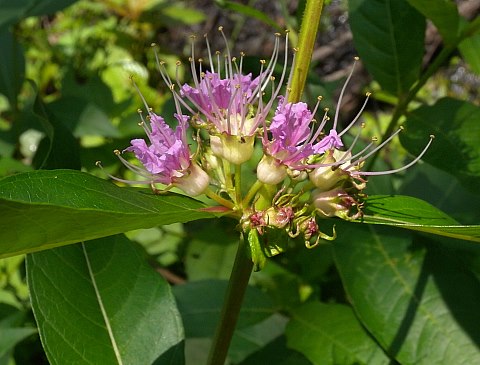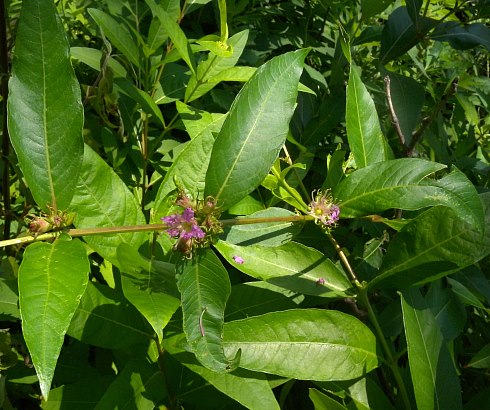
Clusters of non-terminal flowers occur in the axils of the leaves. Individual flowers are up to 1" long and 1" across, consisting of 5 wrinkled purple petals, a short tubular calyx with 5 primary teeth alternating with 5 secondary teeth, 10 stamens of varying lengths, and a pistil with a style. Sometimes there are more calyx teeth and fewer stamens. The bell-shaped calyx is light green to cream-colored with rose tints; its primary teeth are ovate, while its secondary teeth are elevated above the primary teeth and they are linear. The slender secondary teeth are often contorted or crooked and they are ciliate along their margins. The pedicels of the flowers are light green, glabrous or pubescent, and short (about ¼" in length). There are 2 or more leafy bracts underneath each cluster of flowers; they are up to ¾" in length
Cultivation: The preference is full or partial sun, wet to moist conditions, and soil that is mucky, peaty, or sandy (or some combination of the preceding). Swamp Loosestrife is usually an emergent aquatic plant in stagnant or slow-moving water. However, it also colonizes damp ground near shorelines.
Range & Habitat: Swamp Loosestrife is an uncommon wildflower that is found in scattered areas of Illinois. It is apparently absent in the NW and east-central areas of the state. Habitats include marshes and sandy marshes, swamps and sandy swamps, shorelines along ponds and small lakes, calcareous fens, and peaty bogs. Sometimes Swamp Loosestrife occurs on floating mats of vegetation in fens and bogs. It is usually found in high quality wetlands.
Faunal Associations: The flowers are cross-pollinated by honeybees, bumblebees, Swallowtail butterflies, and probably other insects. These visitors obtain primarily nectar from the flowers. The caterpillars of Darapsa versicolor (Hydrangea Sphinx) and Eudryas unio (Pearly Wood Nymph) feed on the foliage, while the caterpillars of Papaipema cataphracta (Burdock Borer Moth) and Papaipema sulphurata (Decodon Borer Moth) bore through the stems. The range of the rare Decodon Borer Moth is restricted to northeastern United States. The seed capsules of Swamp Loosestrife are eaten by several ducks: the Mallard, Black Duck, Blue-Winged Teal, Green-Winged Teal, and Wood Duck. Muskrats like to feed on the swollen and spongy underwater stems.

Photographic Location: Shoreline of a small lake at the Indiana Dunes National Lakeshore in NW Indiana.
Comments: Swamp Loosestrife is both large in size and attractive, especially when it is in bloom. Its two closest relatives in Illinois, the native Lythrum alatum (Winged Loosestrife) and introduced Lythrum salicaria (Purple Loosestrife), prefer somewhat drier areas of wetlands. Compared to Swamp Loosestrife, both of these species have very similar purple flowers, but they are both erect in their habit of growth, rather than arching.